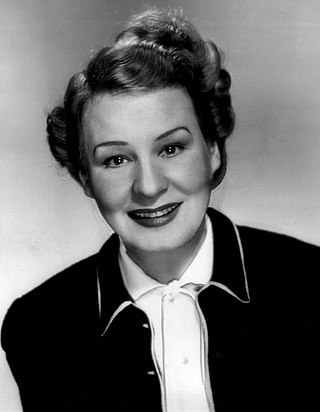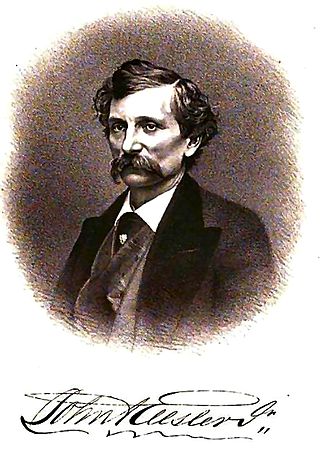
Mary Jeanette Robison, known professionally as May Robson, was an Australian-born American-based actress whose career spanned 58 years, starting in 1883 when she was 25. A major stage actress of the late 19th and early 20th centuries, she is remembered for the dozens of films she appeared in during the 1930s, when she was in her 70s.

Shirley Booth was an American actress. One of 24 performers to achieve the Triple Crown of Acting, Booth was the recipient of an Academy Award, two Primetime Emmy Awards and three Tony Awards.
Colleen Rose Dewhurst was a Canadian-American actress mostly known for theatre roles. She was a renowned interpreter of the works of Eugene O'Neill on the stage, and her career also encompassed film, early dramas on live television, and performances in Joseph Papp's New York Shakespeare Festival. One of her last roles was playing Marilla Cuthbert in the Kevin Sullivan television adaptations of the Anne of Green Gables series and her reprisal of the role in the subsequent TV series Road to Avonlea. In the United States, Dewhurst won two Tony Awards and four Emmy Awards for her stage and television work. In addition to other Canadian honors over the years, Dewhurst won two Gemini Awards for her portrayal of Marilla Cuthbert; once in 1986 and again in 1988. It is arguably her best known role because of the Kevin Sullivan produced series’ continuing popularity and also the initial co-production by the CBC; allowing for rebroadcasts over the years on it, and also on PBS in the United States. The initial broadcast alone was seen by millions of viewers.

Mary Jo Catlett is an American actress. She is a main cast member on the animated series SpongeBob SquarePants, providing the voice of Mrs. Puff. She is also known for originating the role of Ernestina in the 1964 Broadway production of Hello, Dolly! and for playing Pearl Gallagher, the third housekeeper on Diff'rent Strokes.

Lilian Adelaide Neilson, born Elizabeth Ann Brown, was a British stage actress.

Daphne Pollard was an Australian-born vaudeville performer and dancer, active on stage and later in US films, mostly short comedies.

Viola Emily Allen was an American stage actress who played leading roles in Shakespeare and other plays, including many original plays. She starred in over two dozen Broadway productions from 1885 to 1916. Beginning in 1915, she appeared in three silent films.

Madge Evans was an American stage and film actress. She began her career as a child performer and model.

Helen Mack was an American actress. She started her career as a child actress in silent films, moving to Broadway plays and touring one of the vaudeville circuits. Her greater success as an actress was as a leading lady in the 1930s. She made the transition to performing on radio and then into writing, directing, and producing shows during the Golden Age of Radio. She later wrote for Broadway, stage and television. Her career spanned the infancy of the motion picture industry, the beginnings of Broadway, the final days of vaudeville, the transition to sound movies, the Golden Age of Radio, and the rise of television.

Florence Roberts (March 16, 1861/1864 – June 6, 1940 was an American actress of the stage and in motion pictures.

Francis Wilson was an American actor.

Mary Euphemia "Effie" Germon was an American stage actress of the late 19th century from Augusta, Georgia, a descendant of the Germons of Baltimore who were an old theatrical family. She excelled as a soubrette.
Booth's Theatre was a theatre in New York built by actor Edwin Booth. Located on the southeast corner of 23rd Street and Sixth Avenue, Booth's Theatre opened on February 3, 1869.

The first theatre in New York City to bear the name The Winter Garden Theatre had a brief but important seventeen-year history as one of New York's premier showcases for a wide range of theatrical fare, from variety shows to extravagant productions of the works of Shakespeare. Initially known as Tripler's Hall or Metropolitan Hall, it burned down in 1854 and was rebuilt as The New York Theatre. Although it burned to the ground several times, it rose from the ashes under different managers, bearing various names, to become known as one of the most important theatres in New York history.

Grace George was a prominent American stage actress, who had a long career on Broadway stage and also appeared in two films.
Anna-Jane Casey is an English singer, dancer and actress best known for her work in musical theatre.
The Lillian Booth Actors Home of The Actors Fund is an American assisted-living facility, in Englewood, New Jersey. It is operated by the Actors Fund, a nonprofit umbrella charitable organization that assists American entertainment and performing arts professionals.

John A. Ellsler was an American actor, theatre manager and acting instructor who helped make Cleveland, Ohio one of the more important theatre towns in post Civil War America. Ellsler was instrumental in starting the careers of several well known actors of that period including his daughter's, and had once been a friend and business partner of the assassin, John Wilkes Booth.

Euphemia"Effie" Ellsler was an American actress of stage and screen whose career had its beginnings when she was a child and lasted well into the 1930s. She was best remembered over her early career for playing the title role in Steele MacKaye's hit play Hazel Kirke, and as the self-sacrificing Bessie Barton in Frank Harver's Woman Against Woman. Ellsler remained active during her later years appearing between 1901 and 1936 in at least six Broadway productions and twenty-two motion pictures.
Nedda Harrigan Logan was an American actress.















